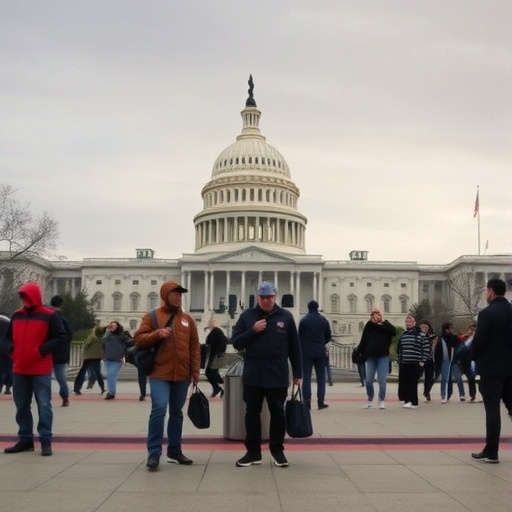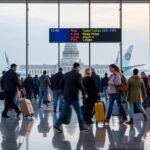Government Shutdown Hits Hard: Unpaid Federal Workers Grapple with Mounting Financial Strains
In a stark reminder of the human cost behind political gridlock, thousands of Federal Workers across the United States are staring down the barrel of financial ruin as the government shutdown stretches into its third week. Without paychecks in hand, these essential employees—ranging from park rangers to air traffic controllers—are forced to ration groceries, delay medical bills, and even consider dipping into retirement savings just to keep the lights on. As the impasse over border funding drags on, the financial strains on unpaid Federal Workers are intensifying, threatening not only their livelihoods but the stability of communities nationwide.
- Federal Workers’ Heartbreaking Stories: Skipping Meals to Pay Rent
- Ripple Effects on Families: Childcare Crises and Mounting Debt
- Community and Economic Fallout: Local Businesses Feel the Pinch
- Bipartisan Voices Rise: Lawmakers Acknowledge Worker Plight
- Long-Term Shadows: Health Risks and Workforce Exodus Loom
The shutdown, triggered by disagreements in Congress over immigration policy and funding for a border wall, has furloughed more than 800,000 federal employees, with around 400,000 working without compensation. This marks the longest shutdown in U.S. history, surpassing the 21-day record set in 1995-1996. According to the Office of Personnel Management, the average federal worker earns about $85,000 annually, translating to roughly $3,000 in lost wages per pay period. For many, this isn’t just a temporary setback—it’s a crisis that could unravel years of careful financial planning.
Federal Workers’ Heartbreaking Stories: Skipping Meals to Pay Rent
At the epicenter of this crisis are the personal tales of resilience and desperation among unpaid federal workers. Take Sarah Jenkins, a 42-year-old biologist with the National Park Service in Virginia. For 15 years, she’s monitored wildlife in Shenandoah National Park, but now, with no income since December 22, she’s making tough choices. “I’ve had to cut out coffee runs and pack lunches from whatever’s left in the pantry,” Jenkins shared in an interview with reporters outside her local food bank. “My kids don’t understand why we can’t go out for pizza anymore. It’s humiliating.”
Jenkins is far from alone. A survey by the National Treasury Employees Union revealed that 78% of affected federal workers are dipping into savings, while 22% have already missed mortgage or rent payments. In high-cost areas like Washington, D.C., where median home prices exceed $600,000, the pressure is acute. One TSA officer at Reagan National Airport, speaking anonymously, described borrowing from family to cover car payments: “I’m on the front lines keeping flights safe, but at home, I’m one late bill away from eviction.” These anecdotes underscore the raw financial strains unpaid federal workers endure, turning routine expenses into insurmountable hurdles.
Statistics paint an even grimmer picture. The Partnership for Public Service estimates that the shutdown could cost the economy up to $4.5 billion per week, much of it siphoned from the pockets of these workers. Food pantries in federal-heavy regions, such as Maryland and Virginia, report a 40% surge in demand. One pantry volunteer in Arlington noted, “We’ve seen lines triple—mostly government folks who never thought they’d need this.”
Ripple Effects on Families: Childcare Crises and Mounting Debt
The financial strains extend beyond individual workers, rippling through families and straining support systems. For single parents like Mark Rivera, a Department of Veterans Affairs claims processor in California, the shutdown means juggling unpaid work with childcare woes. “My daughter’s daycare costs $1,200 a month, and without pay, I’m choosing between that and utilities,” Rivera said during a virtual town hall organized by federal unions. With two weeks of back pay promised once the shutdown ends, but no guarantee of when that will be, many are accruing credit card debt at alarming rates.
Credit reporting agency Equifax has observed a 15% spike in missed payments among federal employee zip codes. Debt counselors report calls from unpaid federal workers up 300% since the shutdown began. “People are maxing out cards for groceries—interest rates are killing them,” explained Lisa Chen, a financial advisor in D.C. One stark example: A Coast Guard family in Miami faced foreclosure after using emergency funds meant for their child’s college tuition. The service, deemed essential, continues operations, but its 40,000 personnel remain unpaid, leading to widespread reports of pawned wedding rings and sold family heirlooms.
Children are bearing the brunt too. Schools in federal-impacted districts note increased absences due to unaffordable meals or transportation. A report from the Children’s Defense Fund highlights that 1 in 5 federal worker households includes a child under 18, amplifying the crisis. “This isn’t just about adults; it’s shattering family stability,” said advocate Maria Gonzalez. As financial strains deepen, unpaid federal workers are turning to gig economies—driving for Uber or freelancing—yet these stopgaps barely cover basics, often exacerbating exhaustion from mandatory unpaid shifts.
Community and Economic Fallout: Local Businesses Feel the Pinch
Beyond personal hardships, the shutdown’s financial strains on unpaid federal workers are battering local economies. In the Washington metro area, where federal jobs dominate, restaurants and retailers are seeing sales plummet by 20-30%. “Our lunch crowd—mostly feds—has vanished,” lamented owner Tom Hargrove of a Capitol Hill deli. The U.S. Chamber of Commerce warns that prolonged shutdowns could shave 0.1% off quarterly GDP growth, with small businesses hit hardest.
In rural areas, the impact is equally severe. National Forest Service employees in Colorado, for instance, support logging and tourism industries. With rangers unpaid, trail maintenance halts, deterring visitors and costing outfitters thousands. A study by the Brookings Institution projects $11 billion in total economic losses by month’s end, including indirect hits from reduced consumer spending. Grocery chains like Safeway report 10% drops in sales near federal installations, as unpaid workers stock up on discount items or skip purchases altogether.
Nonprofits are stepping in where government can’t. The Capital Area Food Bank distributed an extra 500,000 meals last week alone, funded by emergency donations. “We’re bridging gaps, but it’s unsustainable,” said CEO Nancy Roman. Meanwhile, states like California have launched micro-loan programs for affected workers, but demand outstrips supply. These community responses highlight how the financial strains on unpaid federal workers are fracturing the social fabric, prompting calls for federal intervention even amid the deadlock.
Bipartisan Voices Rise: Lawmakers Acknowledge Worker Plight
As the shutdown persists, pressure mounts from both sides of the aisle to address the plight of unpaid federal workers. Senate Minority Leader Chuck Schumer (D-NY) lambasted the situation in a floor speech: “These are patriots serving our nation, not pawns in a political game. Their financial strains demand immediate action.” Even some Republicans, like Sen. Susan Collins (R-ME), have voiced support for short-term funding bills to pay workers retroactively.
House Speaker Nancy Pelosi echoed this, stating, “Federal workers aren’t asking for charity—they’re asking for the pay they’ve earned.” Unions like the American Federation of Government Employees have rallied over 100,000 members in protests, with chants of “Pay Us Now” echoing in D.C. streets. President Trump, in a White House briefing, acknowledged the hardship but tied resolution to border security demands: “Great people, but we need the wall.”
Experts weigh in on potential relief. The Congressional Budget Office suggests a $10 billion emergency fund could cover back pay without derailing negotiations. Bipartisan bills, such as the one introduced by Rep. Gerald Connolly (D-VA), aim to guarantee pay during future shutdowns. Yet, with talks stalled, financial advisors urge workers to tap unemployment benefits—available in 38 states for furloughed feds—or 401(k) loans, though these carry risks like penalties. Quotes from economists, like Mark Zandi of Moody’s Analytics, warn: “This shutdown is eroding trust in government employment, potentially leading to talent exodus.”
Long-Term Shadows: Health Risks and Workforce Exodus Loom
Looking ahead, the prolonged financial strains on unpaid federal workers could have lasting repercussions. Mental health experts report a surge in anxiety and depression cases; the Employee Assistance Program has seen a 50% increase in calls for counseling. “Stress from unpaid bills is leading to sleepless nights and family tensions,” noted psychologist Dr. Elena Vasquez. Physical health suffers too, with delayed doctor visits risking chronic conditions—especially for the 20% of feds without robust savings buffers.
Recruitment challenges may follow. A Government Accountability Office report predicts a 15% drop in federal job applications post-shutdown, as millennials view the instability as a deterrent. Retention is at risk; experienced workers like those at the FDA, vital for drug approvals, might jump to private sector roles offering stability. “We’re losing institutional knowledge,” warned former OMB director Sylvia Burwell.
Potential next steps include Senate votes on clean funding resolutions, expected this week, though partisan lines remain firm. Advocacy groups push for shutdown-proof pay laws, modeled after military protections. For workers, community funds and state aid offer lifelines, but experts stress negotiation breakthroughs are key. As one unpaid IRS auditor put it, “We serve the public—now the public needs to serve us with a resolution.” The path forward hinges on compromise, lest the financial strains evolve into a full-blown workforce crisis.








